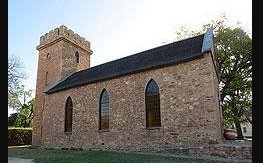The History of Pacaltsdorp

Pacaltsdorp is situated on the outskirts of George on the seaward side of the N2 highway.This area has a rich history.
In the early 1800’s Kaptein Dikkop was the chief of the local Khoi Khoi in the Hoogekraal area.The Khoi were moon worshippers and their clothing and cloaks were made of sheepskin.They were hunter gatherers ,hunting with spears,bow and poisoned arrows.
In 1813 Reverend Read and Winner visited the area and the chief was so impressed with their work,that he requested several times that missionaries come to live and work amongst his people.In 1813 Chief Dikkop got news that Rev Pacalt would come to Hoogekraal.The Chief went to Suurbraak personally with an ox wagon to fetch the Missionaries of the London Missionary Society.The journey took four weeks.Chief Dikkop died in 1816 and was buried outside of the parish grounds as his followers felt he had never converted to Christianity.
The mission station Hoogekraal was named Pacaltsdorp after the death of the German-speaking missionary of Czech origin, the Reverend Charles Pacalt in 1818. He built up a congregation of about 300 Khoekhoen, slaves and free labourers. The Khoekhoe kept sheep and cattle and were nomadic. On revisiting this kraal in 1819 John Campbell ,Director of the London Missionary Society found the settlement surrounded by a wall, six feet in height, five feet thick at the bottom, and tapering to the top, the whole length being 6,767 feet. Enclosures for securing their cattle during the night were surrounded by walls of the same construction .Their gardens contained peach, apricot and fig trees, potatoes, pumpkins, water- melons, cabbages, beans, peas, Indian corn .
“The Tree Of Meeting" is a 300-year-old tree in Missionstreet. It was under this tree that Rev Pacalt would call the Khoi together for meetings.The stone building nearby was originally home to some of the first missionaries. There was no church building yet and church services were conducted under this big Essenwood tree.The tree is situated where Chief Dikkop’s kraal was on the summit of Sandkop.
A number of historic buildings are preserved - The Stone Church - a Norman-style church, originally built from stone, yellowwood, glass and clay. Rev Pacalt's second mission cottage,Die Patat Huisie, was constructed in approximately 1813. Consisting of sod walls, a thatch roof and cow-dung floor, it was declared a national monument in 1976. William Anderson built the first two-storied building with thick stone walls and abundant yellowwood, it was also declared a national monument in 1976.
In 1822 the Reverend William Anderson joined the mission, and both he and his family continued to play a leading role in the affairs of the village for more than a century. The 1875 census indicated that Pacaltsdorp mission station had a population of 495. In 1891 this number had risen to 632, but by 1904 it had dropped to 571.
One of the oldest churches is found in Pacaltsdorp. This imposing Norman style church, also described as Gothic Revival, is unique in South Africa. It’s metre-thick stone walls and tall, square, rough stone Norman tower was originally built from stone, yellowwood, glass and clay. On 19 June 1825 Dr. John Phillip officially opened this unique church which had taken 18 months to complete. The bell on top of the church was imported from England. The church was also used as a school on weekdays.
On 1 December 1837, William Anderson laid he cornerstone of the new school .It was built of materials similar to the great stone church, except that it was plastered on the outside. A new school block was built between 0 and 1951.
The Board House was built for the use of the Village Management Board for meeting and administration. It was fenced during the middle of 1894.
Kaptein Dikkop Amphitheatre is a unique Amphitheatre was built in memory of Chief Dikkop. The Amphitheatre is used for community gatherings and the annual Pacaltsdorp Christmas Lights.
Epenita Jantjies became the Rev. Pacalt’s first ‘Hottentot’ convert at Hoogekraal. She was baptized in the Christian Church on 7 November 1814. She died on the 2 June 1859. She was for more than 44 years a member of the Church of Christ. In 1957, the last of the missionaries were buried in “Missionaries’ Acre.



Share This Post